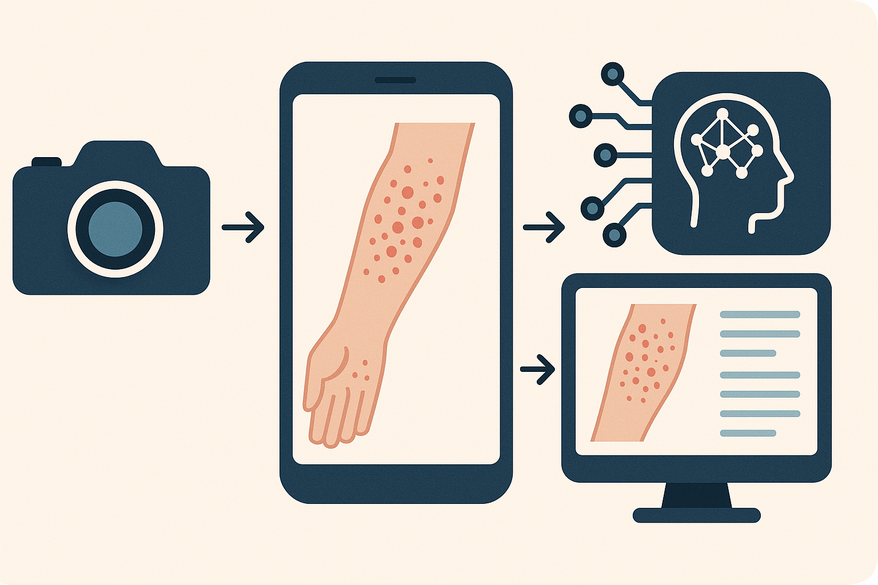Technical Process of Rash Detection Using AI and Machine Learning
Explore the technical process of rash detection with AI and machine learning, from image capture to clinical integration, enhancing diagnostic accuracy.

Estimated reading time: 12 minutes
Key Takeaways
- AI-driven pipelines leverage CNNs and diverse ML techniques to automate rash identification and classification.
- High-quality datasets and robust preprocessing are essential for accuracy and fairness across skin types.
- Privacy-preserving methods like federated learning enable collaboration without sharing raw patient data.
- Clinical integration via EHR, mobile apps, and telemedicine enhances triage and diagnostic workflows.
- Future trends include explainable AI, personalized treatment planning, and continuous monitoring.
Table of Contents
- Overview of Rash Detection in Dermatology
- The Role of Artificial Intelligence in Rash Detection
- Machine Learning Techniques in Diagnosing Skin Conditions
- Step-by-Step Technical Process of Rash Detection
- Challenges and Limitations
- Case Studies and Real-World Applications
- Future Trends and Innovations
- Conclusion
- References
Overview of Rash Detection in Dermatology
Early and accurate rash detection is vital. Many rashes signal systemic disease, infection, or allergic reactions. Detecting these signs promptly improves patient outcomes and reduces complications.
- Importance of Early Detection
• Rashes can be the first sign of autoimmune disorders or viral infections.
• Prompt treatment lowers the risk of spreading infections or chronic damage.
• Automated screening supports triage and prioritizes urgent cases. - Specialist Shortage vs. Rising Demand
• Demand for dermatology consults is growing worldwide.
• Many regions face a shortage of qualified dermatologists.
• Technology-assisted diagnostics help bridge the gap. - AI-Based Tools Transforming Workflows
• VisualDx DermExpert offers differential diagnoses based on image analysis.
• Automated lesion classification can speed up clinic throughput.
• AI integration reduces manual chart review and improves consistency.

The Role of Artificial Intelligence in Rash Detection
AI drives automated image recognition and data analytics to detect key rash features—color, texture, morphology, and distribution. By processing thousands of images, AI systems learn to spot subtle patterns beyond human perception.
Convolutional Neural Networks (CNNs)
- Hierarchical feature learning through layered filters on skin images.
- Early layers detect edges and blobs; deeper layers capture shapes and lesions.
- Transfer learning adapts pre-trained networks to dermatology tasks.
- Popular frameworks include TensorFlow, PyTorch, and Keras.2,3
Performance Metrics
- Sensitivity: up to 0.91 for monkeypox and other infectious rashes.
- Specificity: up to 0.965 in validation studies.
- High ROC-AUC scores indicate strong discrimination.4
AI Application Examples
- VisualDx DermExpert: image upload → CNN analysis → ranked differential.2
- Aysa App: mobile image capture → cloud-based inference → triage advice.1
- Integration with EHR: automated alerts for high-risk skin findings.
Discover how these methods reshape diagnostics in real-world settings. Read more about how AI diagnoses rashes.
Machine Learning Techniques in Diagnosing Skin Conditions
Machine learning empowers rash diagnosis through diverse algorithmic approaches. Each technique addresses specific aspects of image and data analysis for skin conditions.
Supervised Learning
- Models trained on labeled images (eczema, psoriasis, dermatitis).
- Loss functions (cross-entropy, mean squared error) guide optimization.
- Backpropagation adjusts network weights to minimize prediction errors.3,2
Deep Learning & Neural Networks
- CNN architecture: convolutional layers, pooling layers, fully connected layers.
- Pooling reduces spatial dimensionality; fully connected layers perform classification.
- Data augmentation (rotation, flipping) boosts model robustness.3,2
Unsupervised Learning
- Clustering algorithms (k-means, hierarchical clustering) reveal latent rash categories.
- Autoencoders compress images to detect anomalies without labels.
- Useful for exploratory data analysis and rare-condition discovery.
Data Requirements
- Large, diverse annotated datasets are critical for generalization.
- Metadata: patient age, skin type (Fitzpatrick scale), lesion history.
- Public and proprietary image repositories improve coverage.4
Model Validation Strategies
- Cross-validation: k-fold splits test stability across subsets.
- Hold-out test sets measure performance on unseen data.
- Metrics: accuracy, F1 score, precision, recall, ROC-AUC.
- Confusion matrices highlight class-specific errors.
Step-by-Step Technical Process of Rash Detection
This section outlines each phase of an AI-driven rash detection pipeline. Follow these six steps to build or evaluate a diagnostic system.
- Data Collection
• High-resolution image capture with consistent lighting and background.
• Metadata gathering: patient demographics, medical history, lesion onset.
• SOPs for image standards ensure comparability across clinics. - Data Preprocessing
• Normalize images to a fixed resolution (e.g., 224×224 pixels) and calibrate colors.
• Use annotation tools to mark lesion boundaries and labels.
• Anonymize data to comply with HIPAA/GDPR protocols.1 - Feature Extraction
• Handcrafted features: texture descriptors (GLCM), color histograms, shape metrics.
• Deep features: activations from intermediate CNN layers for representation learning. - Model Training
• GPU-accelerated clusters for efficient convergence.
• Optimizers: Adam for adaptive learning rates; SGD for stability.
• Apply learning rate schedules (step decay, cosine annealing) and balanced loss functions for class imbalance. - Validation & Testing
• Evaluate on unseen test sets to gauge real-world performance.
• Employ k-fold cross-validation to reduce sampling bias.
• Analyze confusion matrices and compute precision, recall, and ROC-AUC. - Deployment & Diagnosis
• Integrate models into clinical software or smartphone apps.
• Generate probability scores and heatmaps (e.g., Grad-CAM) to highlight rash regions.
• Implement human-in-the-loop workflows for final clinical decisions.
Challenges and Limitations
- Data Privacy
• Encrypt images at rest and in transit.
• Employ federated learning for privacy-preserving model training.1 - Skin Type Variability
• Bias emerges from underrepresentation of darker Fitzpatrick skin types.
• Diverse, balanced datasets are needed to ensure fairness.2 - Misdiagnoses & False Positives
• AI may misclassify rare conditions, leading to unnecessary biopsies.
• Risk thresholds and clinician oversight help mitigate errors.1,4 - Interpretability
• Deep models can be “black boxes.”
• Use saliency maps (Grad-CAM) and SHAP values to explain predictions.
• Transparent models foster clinician trust. - Regulatory & Ethical Concerns
• FDA and CE regulations govern medical AI deployment.
• Continuous monitoring addresses model drift and performance degradation.1
Case Studies and Real-World Applications
- Aysa App Study
• Analyzed 700 patient images covering common rashes and malignancies.
• Achieved 71% top-1 sensitivity for dermatitis, eczema, and psoriasis.
• Functioned as a decision-support tool, not a standalone diagnostic.1 - VisualDx DermExpert in Primary Care
• Integrated image upload and questionnaire workflows.
• Reduced dermatology referrals by 30% in pilot clinics.
• Improved triage accuracy for urgent rashes like drug eruptions.2 - CNNs for Infectious Disease Outbreaks
• Deployed for monkeypox screening with 0.91 sensitivity and 0.965 specificity.
• Supported rapid public health response and contact tracing.4 - Integration Outcomes
• Clinicians reported faster case discussions using AI-generated heatmaps.
• Under-resourced clinics gained access to expert-level screening.
• Continuous feedback loops refined models with new data.
Future Trends and Innovations
- Federated Learning
• Train decentralized models on local data without sharing raw images.
• Improves global model performance while preserving privacy. - Telemedicine Integration
• Enable remote image capture via smartphones and wearables.
• Deliver real-time cloud-based AI feedback to patients and clinicians. - Explainable AI Advances
• Develop models that generate human-readable rationales.
• Interactive visualizations help clinicians interpret AI outputs. - Personalized Treatment Plans
• Combine genetic, lifestyle, and environmental data for targeted therapies.
• Dynamic algorithms update as new patient information emerges.2,3
For further reading on machine learning in skin analysis, explore this resource.
Conclusion
The technical process of rash detection spans from meticulous image capture and data preprocessing to advanced AI-driven analysis and clinical integration. By leveraging CNNs, supervised learning, and privacy-preserving techniques like federated learning, these systems enhance diagnostic accuracy and expand access to dermatological care.
As AI models mature—bolstered by explainable AI, telemedicine integration, and personalized treatment algorithms—they hold the promise of democratizing skin health worldwide. Continued clinical validation, diverse data collection, and multidisciplinary collaboration are essential to realize this potential.
References
- https://derma.jmir.org/2024/1/e48811
- https://www.visualdx.com/solutions/derm-expert/
- https://onlinelibrary.wiley.com/doi/10.1111/ijd.17076
- https://www.dermatologytimes.com/view/review-investigates-machine-learning-in-skin-disease-identification
FAQ
- What features do AI models use to detect rashes?
Models analyze color variations, texture descriptors, morphological patterns, and spatial distribution to identify abnormalities. - How is patient privacy maintained?
Data are anonymized and encrypted; federated learning allows model training without sharing raw images. - Can AI replace a dermatologist?
AI serves as a decision-support tool; human clinicians review suggestions and make final diagnoses. - What are the limitations of current AI rash detection?
Challenges include skin tone bias, interpretability issues, false positives, and regulatory hurdles. - How can I test my own rash images?
Use the Rash Detector app for instant AI-driven analysis and reports.





